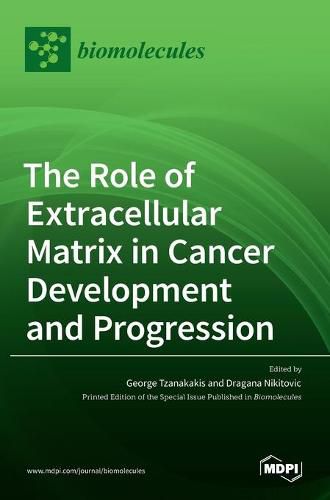Readings Newsletter
Become a Readings Member to make your shopping experience even easier.
Sign in or sign up for free!
You’re not far away from qualifying for FREE standard shipping within Australia
You’ve qualified for FREE standard shipping within Australia
The cart is loading…






This title is printed to order. This book may have been self-published. If so, we cannot guarantee the quality of the content. In the main most books will have gone through the editing process however some may not. We therefore suggest that you be aware of this before ordering this book. If in doubt check either the author or publisher’s details as we are unable to accept any returns unless they are faulty. Please contact us if you have any questions.
The extracellular matrix (ECM) scaffold, which surrounds and supports the cells in tissues, consists of fibrillar proteins, proteoglycans, glycosaminoglycans, signaling molecules, and enzymes involved in its remodeling. The stages of cancer progression, e.g., local invasion, intravasation, extravasation, distant invasion and immunosuppression, are obligatorily perpetrated through interactions of these tumor cells with the ECM. Cancer-related ECM changes can be exploited for the evaluation of disease progression, anticancer therapy development, and monitoring of therapy response. Thus, in breast cancer, hyaluronan-mediated wound repair mechanisms are hijacked to promote tumor development. Altered mechanical properties of the pancreatic cancer ECM are immunosuppressive and prevent the penetration of cytotoxic chemotherapy agents. The expression of the proteoglycan syndecan-4 is modulated by anticancer drugs, suggesting its potential druggabilty capacity. Another proteoglycan, lumican, is proposed as a cancer prognosis marker, chemoresistance regulator, and cancer therapy target. Due to their remodeling properties, the MMPs are vital mediators and important therapeutic targets. Treatment of breast cancer cells with sulfated hyaluronan has been shown to attenuate tumor cell growth, migration, and invasion. Extracellular vesicles (EVs), comprising exosomes, microvesicles, and apoptotic bodies, are released by all cells into the ECM and body fluids and can be utilized as diagnostic markers in malignant pleural mesothelioma. These exciting developments encourage tumor biology scientists for further creative research.
$9.00 standard shipping within Australia
FREE standard shipping within Australia for orders over $100.00
Express & International shipping calculated at checkout
This title is printed to order. This book may have been self-published. If so, we cannot guarantee the quality of the content. In the main most books will have gone through the editing process however some may not. We therefore suggest that you be aware of this before ordering this book. If in doubt check either the author or publisher’s details as we are unable to accept any returns unless they are faulty. Please contact us if you have any questions.
The extracellular matrix (ECM) scaffold, which surrounds and supports the cells in tissues, consists of fibrillar proteins, proteoglycans, glycosaminoglycans, signaling molecules, and enzymes involved in its remodeling. The stages of cancer progression, e.g., local invasion, intravasation, extravasation, distant invasion and immunosuppression, are obligatorily perpetrated through interactions of these tumor cells with the ECM. Cancer-related ECM changes can be exploited for the evaluation of disease progression, anticancer therapy development, and monitoring of therapy response. Thus, in breast cancer, hyaluronan-mediated wound repair mechanisms are hijacked to promote tumor development. Altered mechanical properties of the pancreatic cancer ECM are immunosuppressive and prevent the penetration of cytotoxic chemotherapy agents. The expression of the proteoglycan syndecan-4 is modulated by anticancer drugs, suggesting its potential druggabilty capacity. Another proteoglycan, lumican, is proposed as a cancer prognosis marker, chemoresistance regulator, and cancer therapy target. Due to their remodeling properties, the MMPs are vital mediators and important therapeutic targets. Treatment of breast cancer cells with sulfated hyaluronan has been shown to attenuate tumor cell growth, migration, and invasion. Extracellular vesicles (EVs), comprising exosomes, microvesicles, and apoptotic bodies, are released by all cells into the ECM and body fluids and can be utilized as diagnostic markers in malignant pleural mesothelioma. These exciting developments encourage tumor biology scientists for further creative research.